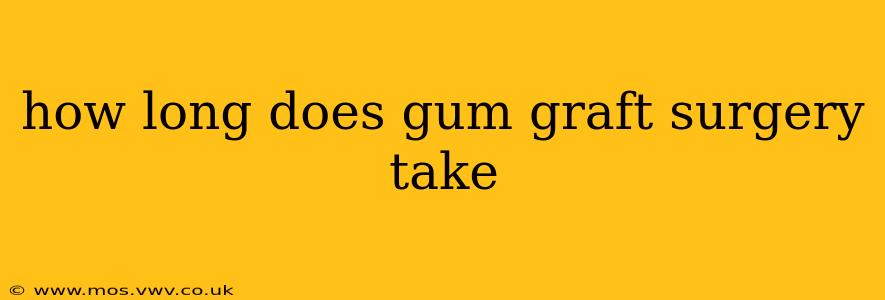How Long Does Gum Graft Surgery Take? A Comprehensive Guide
Gum graft surgery, also known as gingival grafting, is a common periodontal procedure used to address gum recession, exposing the tooth roots and potentially leading to sensitivity, decay, and bone loss. The duration of the surgery varies considerably depending on several factors. This guide will break down the procedure's timeline and address frequently asked questions.
What Factors Influence the Duration of Gum Graft Surgery?
The length of your gum graft surgery depends on several key factors:
-
Type of Gum Graft: There are different types of gum grafts, each with its own procedure time. A free gingival graft (FGG), the most common type, typically takes longer than a connective tissue graft (CTG) or a pedicle graft. The complexity of harvesting the graft material also influences the duration.
-
Extent of Gum Recession: The amount of gum tissue needing replacement directly affects the surgical time. Larger areas of recession require more extensive grafting and therefore more time.
-
Patient's Individual Anatomy: Every patient's mouth is unique. Factors like the thickness of the existing gum tissue, bone structure, and the presence of any underlying conditions can influence the procedure's duration.
-
Surgeon's Experience and Technique: An experienced surgeon may be able to perform the procedure more efficiently and effectively, potentially reducing the overall surgical time.
-
Additional Procedures: If the gum graft is combined with other procedures, like bone grafting or tooth extractions, the overall time will be significantly longer.
How Long is the Surgery Itself?
While it's impossible to give a precise timeframe without a proper consultation with a periodontist, a typical gum graft surgery can last anywhere from 30 minutes to two hours. Simpler grafts, involving smaller areas and utilizing specific techniques, may be completed quicker. More complex procedures requiring extensive grafting or additional procedures will naturally take longer.
What Happens During the Surgery?
The procedure generally involves several steps:
-
Anesthesia: Local anesthesia is administered to numb the area.
-
Graft Harvesting: The surgeon harvests the graft tissue, either from the palate (for FGG and CTG) or from an adjacent area (for pedicle graft).
-
Recipient Site Preparation: The area where the graft will be placed is prepared. This may involve removing any diseased tissue or smoothing the bone surface.
-
Graft Placement and Suturing: The graft is carefully positioned and secured with sutures.
-
Post-Operative Instructions: The surgeon will provide detailed instructions on post-operative care, including pain management and maintaining oral hygiene.
What is the Recovery Time After Gum Graft Surgery?
Recovery time varies depending on the extent of the procedure and individual healing rates. Expect some discomfort, swelling, and bruising for several days. Most patients experience a gradual improvement over several weeks, with full healing taking several months.
Will I Need Multiple Gum Graft Surgeries?
In cases of extensive gum recession, multiple surgeries may be necessary to achieve the desired results. Your periodontist will create a treatment plan tailored to your individual needs, which may involve multiple procedures staged over time.
What are the Potential Risks and Complications?
As with any surgical procedure, there are potential risks and complications associated with gum graft surgery. These can include infection, bleeding, pain, numbness, and graft failure. Your periodontist will discuss these risks in detail during your consultation.
This information is for educational purposes only and should not be considered medical advice. It is crucial to consult with a qualified periodontist to determine the best course of treatment for your specific situation. They can accurately assess your needs, explain the procedure in detail, and provide a realistic timeline based on your individual circumstances.
